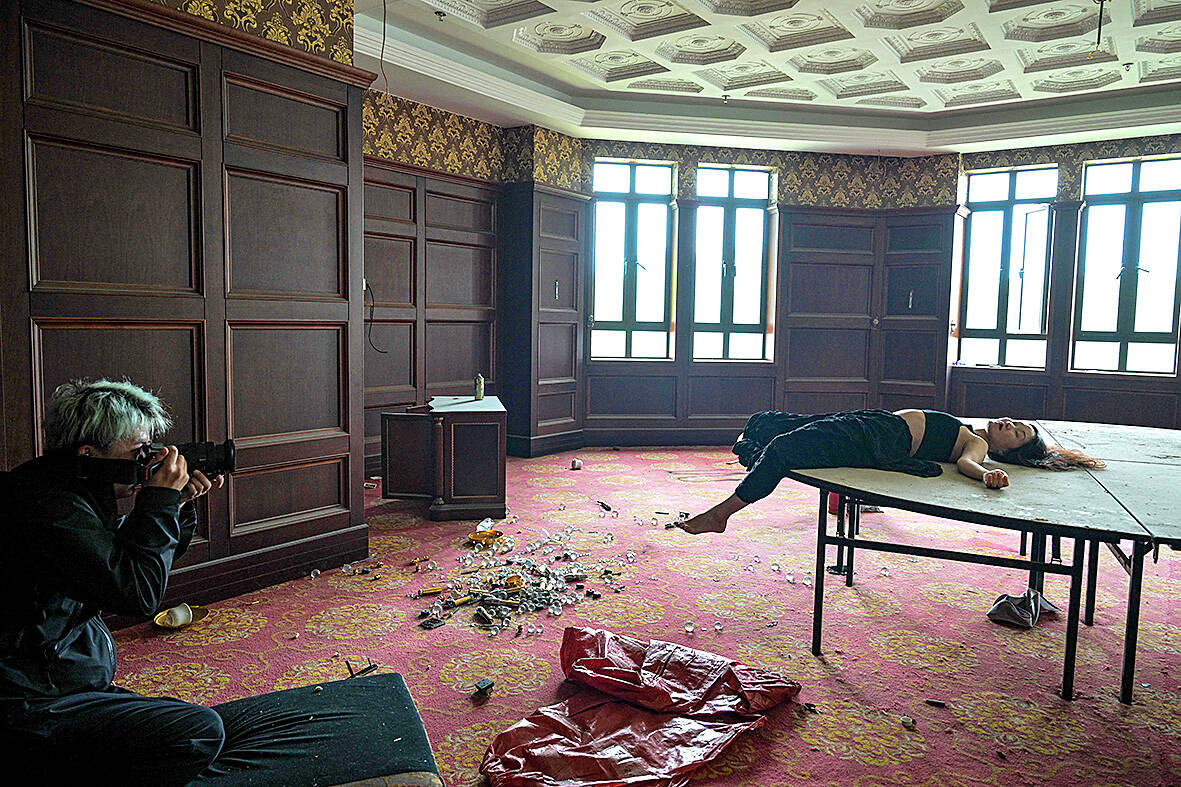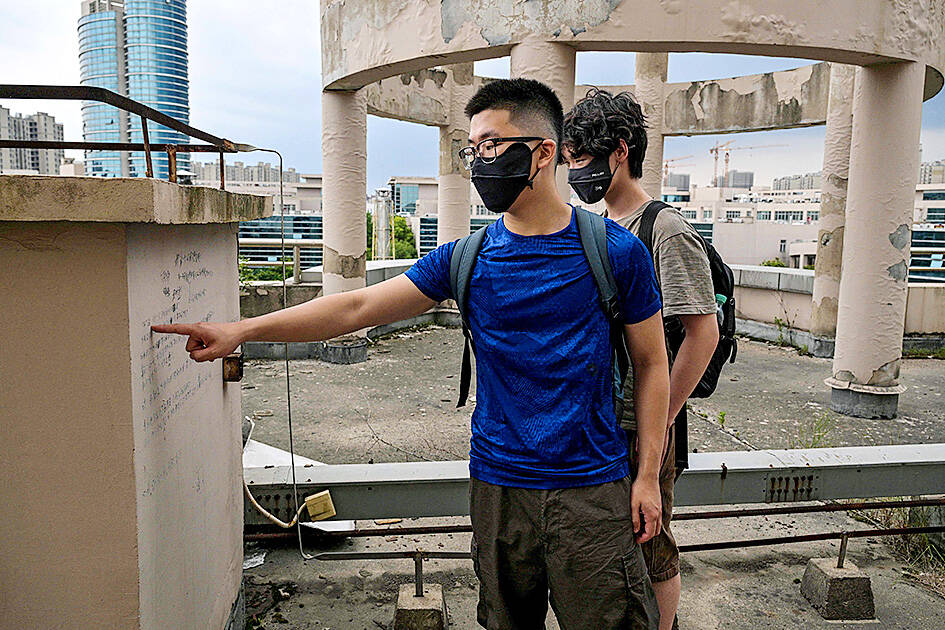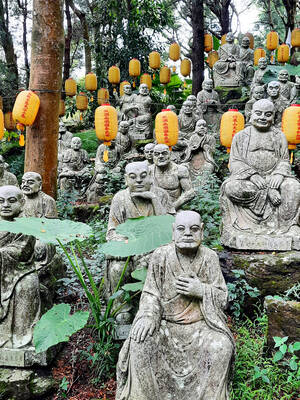Xu Pengcheng looks over his shoulder and, after confirming the coast is clear, helps his crew of urban adventurers climb through the broken window of an abandoned building.
Long popular in the West, urban exploration, or “urbex” for short, sees city-dwelling thrill-seekers explore dilapidated, closed-off buildings and areas — often skirting the law in the process.
And it is growing in popularity in China, where a years-long property sector crisis has left many cities dotted with empty buildings.

Photo: AFP
Xu, a 29-year-old tech worker from the eastern city of Qingdao, has amassed hundreds of thousands of followers for his photos of rundown schools and vacant cinemas. “When people see these images, they find them incredibly fresh and fascinating,” he said.
“The realization that so many abandoned buildings exist — and that they can photograph so beautifully — naturally captures attention.”
Xu and his comrades arrived on May 24 at a deserted hotel in the outskirts of Shanghai for a unique photoshoot.

Photo: AFP
From the outside, the hotel looked like a prefabricated medieval castle. Once inside, it was clear the property had been abandoned for years. Searching through the rooms for good spots for striking photos, Xu and his friends came across remnants of the hotel’s past — a mahjong table, laundry sheets and piles of dinner plates. Props from past photoshoots were scattered on the floor and on one ballroom wall, “Long Live Chairman Mao” was written in spray paint.
China’s recent property market downturn has left many abandoned large-scale projects ready ground for urban explorers.
“I don’t think you would find sites like this in Europe,” long-time explorer Brin Connal said as he walked around an empty, abandoned building.

Photo: AFP
“In China, there’s a lot of these places which are unfinished.”
SENSE OF COMMUNITY
One such unfinished megaproject in Shanghai, the Pentagon Mall, has become such a hotspot that explorers leave messages for each other on the walls of its top floor.
“I think this is something really special about Chinese urban exploration,” said Sean, a Shanghai resident who did not want to give his real name. “There’s a very strong sense of community and it’s very, very welcoming.”
Situated in Shanghai’s Pudong district, the project came close to completion in 2009 but investment fell through.
The giant concrete building now sits mostly in disrepair — broken tiles litter the ground and a large faded map of the uncompleted mall is barely visible under a thick layer of dust. Some rooms still have signs of life, with mattresses from squatters, discarded takeout and cigarette boxes and even laundry hanging outside.
“In places like Shanghai, people always find a way to make use of these buildings, even if they’re not completely built and completely usable,” said Sean’s exploration partner Nov, who also asked to go by a pseudonym.
WAY TOO DANGEROUS
Chinese social media companies are less enthusiastic. Looking up abandoned buildings on Instagram-like Xiaohongshu, users are met with a message warning “there are risks in this area, please pay attention to safety and comply with local policies and regulations.”
Connal, originally from the UK, said he understood the restrictions. “Some of them are way too dangerous, and some of these abandoned locations were getting overwhelmed with people,” he said.
The hobby also takes place in a legal grey area.
Many urban explorers go by a simple mantra — taking nothing from the places they visit and leaving nothing behind. But the act of trespassing can come with fines in China, just as it does in the West. Xu also acknowledged the risks that come with urban exploration — from angry security guards to errant circuitry.
“Firstly, you might face the risk of trespassing illegally. Secondly, private properties may have security guards or be completely sealed off,” he said. “These locations often involve hazards like no electricity or lighting, structural damage, and injuries from construction materials like exposed nails.” But model Mao Yi said the hobby offered a respite from the drudgery of big city living.
“Living in these sprawling metropolises of steel and concrete, we’ve grown familiar with the routines of daily life,” she said.

US President Donald Trump may have hoped for an impromptu talk with his old friend Kim Jong-un during a recent trip to Asia, but analysts say the increasingly emboldened North Korean despot had few good reasons to join the photo-op. Trump sent repeated overtures to Kim during his barnstorming tour of Asia, saying he was “100 percent” open to a meeting and even bucking decades of US policy by conceding that North Korea was “sort of a nuclear power.” But Pyongyang kept mum on the invitation, instead firing off missiles and sending its foreign minister to Russia and Belarus, with whom it

When Taiwan was battered by storms this summer, the only crumb of comfort I could take was knowing that some advice I’d drafted several weeks earlier had been correct. Regarding the Southern Cross-Island Highway (南橫公路), a spectacular high-elevation route connecting Taiwan’s southwest with the country’s southeast, I’d written: “The precarious existence of this road cannot be overstated; those hoping to drive or ride all the way across should have a backup plan.” As this article was going to press, the middle section of the highway, between Meishankou (梅山口) in Kaohsiung and Siangyang (向陽) in Taitung County, was still closed to outsiders

Many people noticed the flood of pro-China propaganda across a number of venues in recent weeks that looks like a coordinated assault on US Taiwan policy. It does look like an effort intended to influence the US before the meeting between US President Donald Trump and Chinese dictator Xi Jinping (習近平) over the weekend. Jennifer Kavanagh’s piece in the New York Times in September appears to be the opening strike of the current campaign. She followed up last week in the Lowy Interpreter, blaming the US for causing the PRC to escalate in the Philippines and Taiwan, saying that as

The Chinese Communist Party (CCP) has a dystopian, radical and dangerous conception of itself. Few are aware of this very fundamental difference between how they view power and how the rest of the world does. Even those of us who have lived in China sometimes fall back into the trap of viewing it through the lens of the power relationships common throughout the rest of the world, instead of understanding the CCP as it conceives of itself. Broadly speaking, the concepts of the people, race, culture, civilization, nation, government and religion are separate, though often overlapping and intertwined. A government